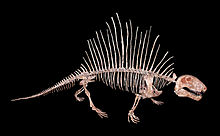
Back سفنكدونات Arabic سفنكدونات ARZ স্ফেনাকোডন্টিডে Bengali/Bangla Esfenacodòntids Catalan Sphenacodontidae Czech Sphenacodontidae German Σφηνακοδοντίδες Greek Sphenacodontidae Spanish گوهدندانان Persian Sphenacodontidae Finnish
| Sphenacodontidae Temporal range: Pennsylvanian - Guadalupian,
| |
|---|---|

| |
| Dimetrodon limbatus skeleton | |
| Scientific classification | |
| Domain: | Eukaryota |
| Kingdom: | Animalia |
| Phylum: | Chordata |
| Clade: | Synapsida |
| Clade: | Sphenacodontoidea |
| Family: | †Sphenacodontidae Marsh, 1878 |
| Genera & clades | |
Sphenacodontidae (Greek: "wedge point tooth family") is an extinct family of sphenacodontoid synapsids. Small to large, advanced, carnivorous, Late Pennsylvanian to middle Permian "pelycosaurs". The most recent one, Dimetrodon angelensis, is from the latest Kungurian or, more likely, early Roadian San Angelo Formation.[1][2] However, given the notorious incompleteness of the fossil record, a recent study concluded that the Sphenacodontidae may have become extinct as recently as the early Capitanian.[3] Primitive forms were generally small (60 cm to 1 meter), but during the later part of the early Permian these animals grew progressively larger (up to 3 meters or more), to become the top predators of terrestrial environments.[4] Sphenacodontid fossils are so far known only from North America and Europe.
- ^ Olson, Everett C. (1962). "Late Permian terrestrial vertebrates, U.S.A. and U.S.S.R." Transactions of the American Philosophical Society. New Series. 52 (2): 1–224. doi:10.2307/1005904. JSTOR 1005904.
- ^ Laurin, Michel; Hook, Robert W. (2022). "The age of North America's youngest Paleozoic continental vertebrates: a review of data from the Middle Permian Pease River (Texas) and El Reno (Oklahoma) Groups". BSGF - Earth Sciences Bulletin. 193: 10. doi:10.1051/bsgf/2022007.
- ^ Didier, Gilles; Laurin, Michel (2021). "Distributions of extinction times from fossil ages and tree topologies: the example of some mid-Permian synapsid extinctions". PeerJ. 9 (e12577): e12577. doi:10.7717/peerj.12577. PMC 8667717. PMID 34966586.
- ^ Jörg Fröbisch; Rainer R. Schoch; Johannes Müller; Thomas Schindler; Dieter Schweiss (2011). "A new basal sphenacodontid synapsid from the Late Carboniferous of the Saar-Nahe Basin, Germany". Acta Palaeontologica Polonica. 56 (1): 113–120. doi:10.4202/app.2010.0039.